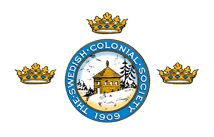Jürgen Schneeweiss, Progenitor of the Keen Family
by Dr. Peter Stebbins Craig
Fellow, American Society of Genealogists
Fellow, Genealogical Society of Pennsylvania
Historian, Swedish Colonial Society
originally published in Swedish Colonial News, Volume 1, Number 11 (Spring 1995)
Governor Printz’ Monatgelderbuch, 1643-1653, recorded that the New Sweden soldier known as Jürgen Schneeweiss came from “Sachsen” (Saxony, Germany).
This fact was not known when Dr. Gregory B. Keen, a descendant of Jürgen Schneeweiss and Secretary of the Historical Society of Pennsylvania, wrote a series of articles for the Pennsylvania Magazine of History & Biography, 1878-1883, “The Descendants of Jöran Kyn of New Sweden,” in which he wrote that the progenitor ofthe Keen family was born in Sweden. In 1913, Dr. Keen, then Vice President of the Swedish Colonial Society, republished this genealogy (with additions) as a book by the same name. By this time Dr. Keen should have known better. In the preceding years, Dr. Amandus Johnson had traveled to Sweden, examined the records of the New Sweden soldiers and undoubtedly informed Dr. Keen, his mentor, of his discovery.
Dr. Keen, however, apparently was unwilling to admit his own error. As a compromise, therefore, Dr. Amandus Johnson’s 1911 book, Swedish Settlements on the Delaware, 1638-1664, omitted any reference to Jürgen Keen’s national origin. Thus, the myth created by Dr. Keen remained unchallenged until recent years when a fresh look at the original records revealed much new information not published by either Dr. Keen or Dr. Johnson, both known as New Sweden scholars in their time.
The history of Jürgen Schneeweiss prior to 1642 is unknown other than the fact that he came from Saxony. Undoubtedly, he was among the many Germans recruited into the Swedish army during the Thirty Years War. His name translates into English as “George Snow-white,” the second name being indicative of his personal appearance, possibly the color of his hair or the lightness of his complexion, or both. After becoming a freeman, he substituted the word Kühn, meaning “bold” in German, which became the family surname. Variously spelled as Kijn, Kyn, Kien, Kühn or Keen, the surname eventually became standardized as Keen.
Jürgen Schneeweiss went on the New Sweden payroll on 1 Sept. 1642 when he was advanced three months’ wages in Stockholm (30 guilders). He sailed to America on the Swan, arriving in the New Sweden colony with Governor Printz on 15 Feb. 1643. He served as a soldier under Printz until 1653 when Printz returned to Sweden.
Choosing to remain in America, Jürgen adopted the surname of Kühn (Keen) and settled on Upland Creek. An English patent, issued 4 August 1668, described his lands as comprising 400 acres in three separate lots.
On 7 April 1663, before the Upland Court, Jurriaen Kyn (as he was called by the Dutch court clerk) sued Evert Hendricksson the Finn for assault and battery. The defendant was convicted and expelled from the colony, only to be granted refuge at Crane Hook by Gov. d’Hinoyossa of New Amstel.
The last known reference to the old soldier occurred on 1 March 1687/8 when “Urine Keen” conveyed his lot in Chester town (former Upland) for a Quaker meeting house. His other lands had previously been transferred to his three known children:
Hans Keen, apparently the eldest son, sold his Upland property to his brother Jonas in 1678 and moved to Pennypack Creek in what later became Oxford Township or Tacony. He died before 10 August 1684, when his widow Williamke Kühn was listed as a contributor to the Wicaco church. She later became the second wife of Caspar Fisk (Fish). Hans and Williamke had five surviving children: Matthias (born 1667), Eric, Jonas, Gertrude and George, all of whom married and had children.
Jonas Keen was of age by 17 May 1675 when he was named Ensign of the Upland Court militia. By 1680 he had moved to Burlington County NJ, where he acquired a share of Hans Monsson’s 500 acre plantation at Senamensing. He apparently moved from this location in 1693, because on 2 March 1694/5 administration of the estate of “Jonas Skeen” of Cesarie River (Cohansey Creek) was granted to his widow Catharine by the Salem County NJ court. His widow Catharine was buried at the Swedish church on Raccoon Creek (Swedesboro), 5 Oct. 1715. Only three of their six children have been identified: Måns (born c. 1678), George and Catharine.
Anna Keen was married about 1668 to James Sandelands, an English soldier of Scotch birth who obtained a 200-acre patent on Upland Creek on 4 Aug. 1668 and his discharge from the army in 1669. He died in Chester, 12 April 1692, survived by his wife, two married daughters (Eleanor, wife of George Foreman, and Catharine, wife of Jasper Yeates) and five minor children: Christian, Mary, James, Jonas and Lydia. Anna then married Peter Baynton (English) in 1692 and had an additional child, Rebecca, born c. 1693/4. Her second husband deserted her and returned to England. Anna was buried 5 Oct. 1704 at St. Paul’s Church in Chester, beside her first husband.
